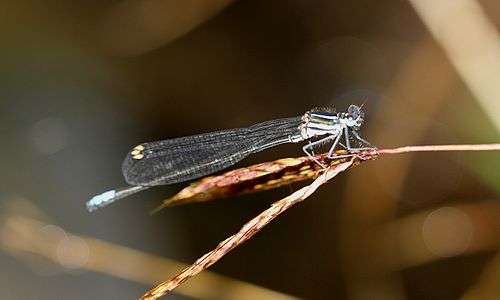Caconeura gomphoides
Caconeura gomphoides[2][1] is a damselfly species in the family Platycnemididae. It is endemic to high altitude peat bogs and grassy uplands in Nilgiris.[1][3]
| Caconeura gomphoides | |
|---|---|
 | |
| Scientific classification | |
| Kingdom: | |
| Phylum: | |
| Class: | |
| Order: | |
| Family: | |
| Genus: | Caconeura |
| Species: | C. gomphoides |
| Binomial name | |
| Caconeura gomphoides (Rambur, 1842) | |
| Synonyms | |
| |
Description and habitat
It is a medium sized damselfly with black-capped blue eyes. Its thorax is black on dorsum and azure blue on the sides. There is a very narrow azure blue antehumeral stripe and a moderately broad black stripe on the postero-lateral suture on each side. Wings are transparent with reddish-brown pterostigma, framed in thick black nervures. Abdomen is black with azure blue stripes on segment 1 and 2. Segment 3 to 6 have narrow basal rings in azure blue. Segments 8 to 10 are entirely azure blue. Female is similar to the male. It can be distinguished from all other species of this genus by the reddish-brown color of the pterostigma and by the mid-dorsal mark on segment 2. It is also comparatively short and thick than other similar species.[4][5]
It breeds in small streams in Nilgiris. Commonly found in grassy upland, clinging to ferns on the banks of small streams covered with grass.[4][6][7][8]
See also
- List of odonates of India
- List of odonata of Kerala
References
- Kakkasery, F. (2011). "Caconeura gomphoides". IUCN Red List of Threatened Species. 2011: e.T175177A7117753.
- Martin Schorr; Dennis Paulson. "World Odonata List". University of Puget Sound. Retrieved 12 Oct 2018.
- K.A., Subramanian; K.G., Emiliyamma; R., Babu; C., Radhakrishnan; S.S., Talmale (2018). Atlas of Odonata (Insecta) of the Western Ghats, India. Zoological Survey of India. pp. 92–93. ISBN 9788181714954.
- C FC Lt. Fraser (1933). The Fauna of British India, including Ceylon and Burma, Odonata Vol. I. Red Lion Court, Fleet Street, London: Taylor and Francis. pp. 252–254.
- Laidlaw, F. F. (1917). "A list of the Dragonflies Recorded from the Indian Empire with Special Reference to the Collection of the Indian Museum" (PDF). Rec. Indian Mus. 13: 347–348. Retrieved 18 October 2018.
- C FC Lt. Fraser (1924). A Survey of the Odonate (Dragonfly) Fauna of Western India with Special Remarks on the Genera Macromia and Idionyx and Descriptions of Thirty New Species (PDF). Zoological Survey of India. Volumes (Records). pp. 505–506.
- Subramanian, K. A. (2005). Dragonflies and Damselflies of Peninsular India - A Field Guide.
- "Caconeura gomphoides Rambur, 1842". India Biodiversity Portal. Retrieved 2017-03-10.
External links
![]()
![]()
